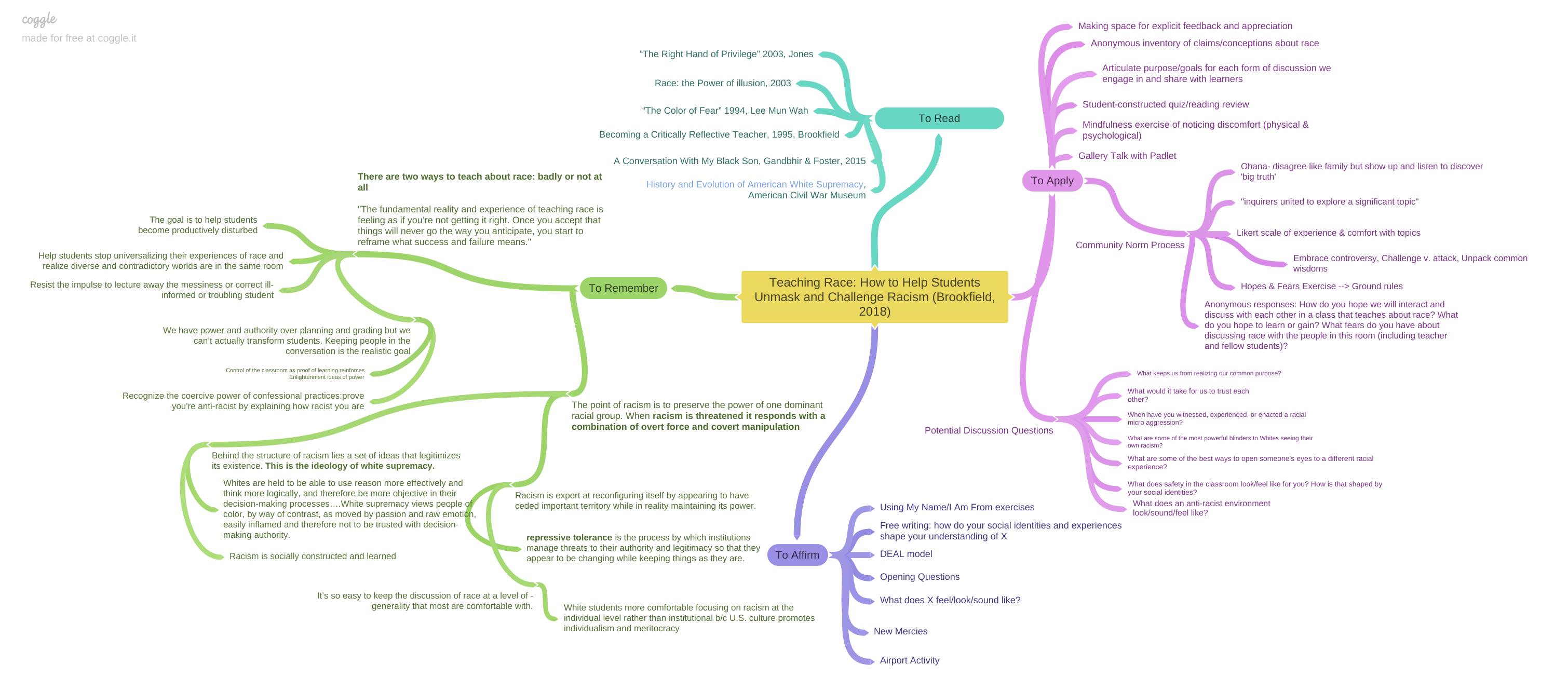What I Learned from “Teaching Race”
January 11, 2021
No Comments
Continuing our commitment to anti-racist learning and action, Office of Community Engagement staff recently finished reading Teaching Race: Helping Students Unmask and Challenge Racism, by Stephen Brookfield and Assoc. (2018). This was our second shared reading after Teaching to Transgress.
One of the tools I gleaned from the book was Coggle, an online mind-mapping tool. So here are my reading notes in Coggle form:
For those who find the Coggle format less accessible, I’ve also written highlights in the standard list form.
To Remember About Race & Racism
- The point of racism is to preserve the power of one dominant racial group. When racism is threatened it responds with a combination of overt force and covert manipulation.
- “Racism is expert at reconfiguring itself by appearing to have ceded important territory while in reality maintaining its power.” Repressive tolerance is the process of appearing to change while keeping the structures in tact.
- “Behind the structure of racism lies a set of ideas that legitimizes its existence. This is the ideology of white supremacy.”
To Remember About Teaching Race
- There are two ways to teach about race: badly or not at all. “The fundamental reality and experience of teaching race is feeling as if you’re not getting it right. Once you accept that things will never go the way you anticipate, you start to reframe what success and failure means.”
- The goal is to help students become productively disturbed, and to help students stop universalizing their experiences of race and realize diverse and contradictory worlds are in the same room.
- It’s easy to keep the conversation about race at a level that most White people are comfortable with, especially by focusing on individual racism and reinforcing beliefs of meritocracy
- We can’t actually transform others by force of will or teaching techniques. Keeping people in the conversation is the realistic goal.
To Read
- The Color of Fear, 1994, Wah
- Becoming a Critically Reflective Teacher, 1995, Brookfield
- History and Evolution of American White Supremacy, 2020, American Civil War Museum
- The Right Hand of Privilege, 2013, Jones
- Race: The Power of an Illusion, 2003, California Newsreel
To Apply
- Framework of learning community as inquirers united to explore and as family who may disagree but must show up and listen to discover ‘big truths’
- Discussion questions such as: What keeps us from realizing our common purpose? When have you witnessed, experienced, or enacted racial microagressions? What does classroom safety look and feel like to you, and how is that shaped by our social identities?
- Challenging rote discussion norms and moving toward embracing controversy, unpacking common wisdoms, and identifying hopes and fears
Categories: Community Engagement & Service, Diversity, Faculty & Staff Blogs





No comments.
Comments are currently closed. Comments are closed on all posts older than one year, and for those in our archive.